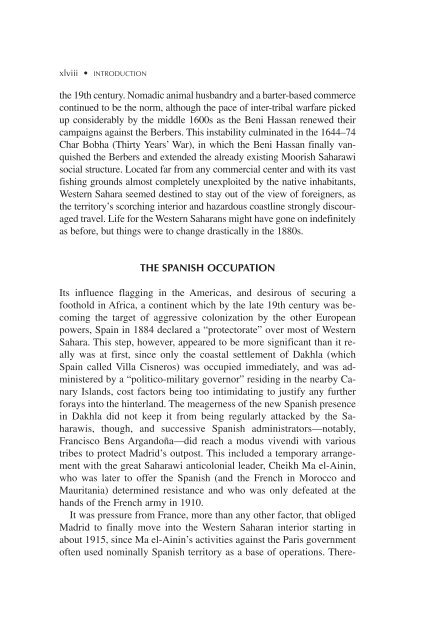Historical Dictionary of Western Sahara Third ... - Scarecrow Press
Historical Dictionary of Western Sahara Third ... - Scarecrow Press
Historical Dictionary of Western Sahara Third ... - Scarecrow Press
You also want an ePaper? Increase the reach of your titles
YUMPU automatically turns print PDFs into web optimized ePapers that Google loves.
xlviii • INTRODUCTION<br />
the 19th century. Nomadic animal husbandry and a barter-based commerce<br />
continued to be the norm, although the pace <strong>of</strong> inter-tribal warfare picked<br />
up considerably by the middle 1600s as the Beni Hassan renewed their<br />
campaigns against the Berbers. This instability culminated in the 1644–74<br />
Char Bobha (Thirty Years’ War), in which the Beni Hassan finally vanquished<br />
the Berbers and extended the already existing Moorish <strong>Sahara</strong>wi<br />
social structure. Located far from any commercial center and with its vast<br />
fishing grounds almost completely unexploited by the native inhabitants,<br />
<strong>Western</strong> <strong>Sahara</strong> seemed destined to stay out <strong>of</strong> the view <strong>of</strong> foreigners, as<br />
the territory’s scorching interior and hazardous coastline strongly discouraged<br />
travel. Life for the <strong>Western</strong> <strong>Sahara</strong>ns might have gone on indefinitely<br />
as before, but things were to change drastically in the 1880s.<br />
THE SPANISH OCCUPATION<br />
Its influence flagging in the Americas, and desirous <strong>of</strong> securing a<br />
foothold in Africa, a continent which by the late 19th century was becoming<br />
the target <strong>of</strong> aggressive colonization by the other European<br />
powers, Spain in 1884 declared a “protectorate” over most <strong>of</strong> <strong>Western</strong><br />
<strong>Sahara</strong>. This step, however, appeared to be more significant than it really<br />
was at first, since only the coastal settlement <strong>of</strong> Dakhla (which<br />
Spain called Villa Cisneros) was occupied immediately, and was administered<br />
by a “politico-military governor” residing in the nearby Canary<br />
Islands, cost factors being too intimidating to justify any further<br />
forays into the hinterland. The meagerness <strong>of</strong> the new Spanish presence<br />
in Dakhla did not keep it from being regularly attacked by the <strong>Sahara</strong>wis,<br />
though, and successive Spanish administrators—notably,<br />
Francisco Bens Argandoña—did reach a modus vivendi with various<br />
tribes to protect Madrid’s outpost. This included a temporary arrangement<br />
with the great <strong>Sahara</strong>wi anticolonial leader, Cheikh Ma el-Ainin,<br />
who was later to <strong>of</strong>fer the Spanish (and the French in Morocco and<br />
Mauritania) determined resistance and who was only defeated at the<br />
hands <strong>of</strong> the French army in 1910.<br />
It was pressure from France, more than any other factor, that obliged<br />
Madrid to finally move into the <strong>Western</strong> <strong>Sahara</strong>n interior starting in<br />
about 1915, since Ma el-Ainin’s activities against the Paris government<br />
<strong>of</strong>ten used nominally Spanish territory as a base <strong>of</strong> operations. There
















